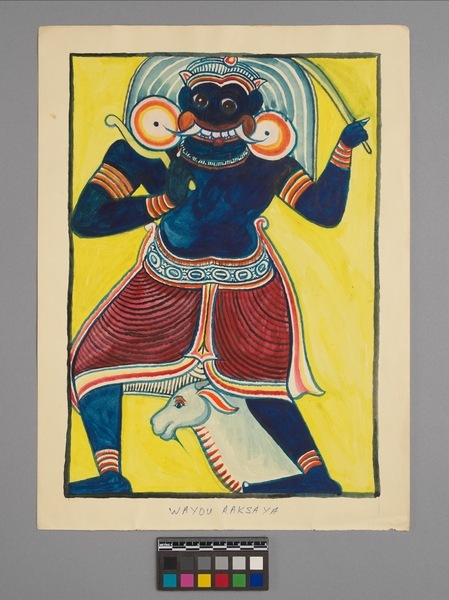Wayou Raksaya Item Number: 3392/26 from the MOA: University of British Columbia

Description
A watercolour painting which depicts a spiritual being with the head of an animal at its feet. The being has dark blue skin. It is wearing a red skirt that ends just below the knee and curls outward at the hip. The bottom of the skirt has a border made up of white, yellow, and red horizontal stripes. The main body of the skirt is covered in thinner horizontal stripes, and consists of two pieces which come together in the front. A long piece of fabric hangs down from the waistband, which is decorated with a repeating circular pattern. Decorative bands encircle the being's biceps, wrists, and ankles. There is an additional adornment around its neck. The being has large, round eyes and a grinning fanged mouth. Its skin is dark enough that its nose is barely visible. The being is wearing a headdress that comes to a point on both sides. Two large discs protrude from the sides of its head. The being is holding curved blades in both of its hands. The longer blade is held up above its head, while the shorter blade rests on its shoulder. The animal head at the being's feet is light blue, with orange accents. It has a small beard, long face and ears, and horns which curve slightly backward. The painting's background is bright yellow, and a rectangular black border surrounds the image. Blue and white oblong rings radiate from the being's head and shoulders.
History Of Use
The imagery is possibly associated with ritual healing in Sri Lanka. The set of watercolours (3392/3-34) is said to depict spirits that inhabit planets, or deviyo (minor gods) or rakshas and yakkas (evil or mischievous beings). These beings are often depicted in masked dances and exorcisms.
Iconographic Meaning
Identified as a Raksha (demon)/Yakka; mischievous or evil.
Narrative
The collector, Dr. Michael Egan, wrote his doctoral thesis on healing rituals in Sri Lanka. His fieldwork was carried out in the south of Sri Lanka, in the village of Kadurupokuna (Hambantota District), between Sept. 1965 and Nov. 1966.
Item History
- Made in Sri Lanka between 1960 and 1966
- Collected between 1965 and 1966
- Owned by Michael John Egan before 1977
- Owned by Carol Egan before October 2, 2019
- Received from Carol Egan (Donor) on October 2, 2019
What
- Name
- Wayou Raksaya
- Identification Number
- 3392/26
- Type of Item
- painting
- Overall
- height 37.3 cm, width 27.4 cm
Who
- Culture
- Sinhalese
- Previous Owner
- Michael John Egan and Carol Egan
- Received from
- Carol Egan (Donor)
Where
- Holding Institution
- MOA: University of British Columbia
- Made in
- Sri Lanka
When
- Creation Date
- between 1960 and 1966
- Collection Date
- between 1965 and 1966
- Ownership Date
- before 1977 and before October 2, 2019
- Acquisition Date
- on October 2, 2019
Other
- Item Classes
- paintings; works on paper
- Condition
- good
- Accession Number
- 3392/0026